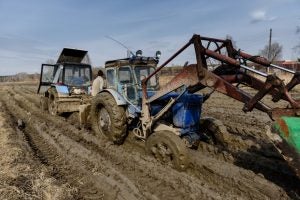“Can you pull me out? I’m stuck.”
It’s going to happen to everyone at some point, and most farmers and ranchers probably share a similar sentiment: When equipment is stuck, everyone’s looking to get it free and running as soon as possible. Growers are often faced with short timeframes to get things done, and it never fails that during your busiest time, someone’s going to get a piece of equipment lodged somewhere it shouldn’t be.
However, the tensions that extractions put on chains, straps, and cables can put operators, bystanders, and extractors in danger whether pulling equipment, tractors, or even trucks out of mud, sand, or snow. Social media even sometimes shows the difficult and heartbreaking images of the aftermath of dangerous incidents, like one in which a driver was killed after a towing vehicle’s hitch broke, crashing through his front windshield.
It’s crucial to approach equipment extraction seriously and cautiously — every situation is different. Here are some tips to help protect your people and equipment when things get stuck:

1. Be aware of what’s happening and anticipate the unexpected.
Just because you’ve extracted equipment successfully before, remember that each situation is different. Assess all of the equipment and account for factors surrounding the situation. Towing vehicles need to be at least as heavy as the stuck vehicle — and if you don’t have one, then it’s probably time to call a professional. Look at ways that you can reduce the forces of resistance. Can you tow from solid ground? Can you approach a sunken vehicle from a higher vantage point or using an elevated attachment point to reduce resistance?
2. Choose proper connecting equipment
It’s essential that your towing and pulling equipment is rated for the job at hand. Underrated, damaged, or improperly used devices will eventually fail — putting everyone and everything in their path at risk.
Used chains, straps, and cables may not have clearly marked (or known) ratings or have been damaged by previous use. Every device used to extract equipment has a breaking point when it exceeds the device rating (and some materials, like steel, may gradually bend before failing under normal use, while something like titanium looks fine until failure is sudden and catastrophic). Ensure that what you purchase is at least one time the weight of the stuck equipment, but be sure to factor in just how stuck things are — this will increase the resistance factors.
It’s likely worthwhile to dispose of equipment you may have on hand and purchase recovery equipment based on your needs rather than risk having someone use straps not meant for the job.
Types of recovery equipment:
Recovery straps or ropes (sometimes called jerk ropes) can be used in cases where equipment might need to be jerked on. These recovery devices are designed to stretch under tension. Although farmers have likely been using chains and cables for years, straps are generally safer. Straps should be flat and free of knots to ensure that there are no unintended weak points.
Chains may be the device most familiar to many farmers and ranchers. However, chains may not be the best choice for recovering stuck equipment. Links stretch, the materials will rust, and they are not suited for jerking — an action that can have deadly consequences.
If you’re using a chain, take a look at the rating, and make sure that chains, links, and hooks have the same rating — they will only be as strong as the weakest point.
Cables or wire ropes are commonly used by professionals who extract equipment. Cables, however, are not designed for impact and should never be jerked. Cables will only work properly if there is not too much damage to the fibers, and that the length, clips, and thimble are attached correctly. One way to ensure that your cable can meet your needs is to order one from a professional to meet your specified needs.
Tow ropes or tow straps should not be used for extraction — they are only designed for towing.
Cable blankets can be placed on straps, chains, or ropes to prevent recoil. If one of these is not present, a jacket, truck mat, or similar can help push downward instead of into the air.
3. Ensure attachment devices have adequate ratings
Any item used to extract stuck vehicles or equipment need to have an adequate rating. Metal, in particular, will snap (and recoil with deadly consequences) when placed under too much stress.
A jerk rope or strap is safer to break than the thing it’s attached to. Many pieces of equipment have a draw bar that can be used, but it’s integral to make sure the hitch and safety pin are strong enough to keep from separating. Pickups, similarly, often have hooks installed for the purpose of extraction, but these too will have a rating.
Hitches are NOT the best tool to use when extracting equipment — these are designed to handle direct pulls, not indirect pressure or jerks.
4. Make sure there’s a clear zone
Ensure that all bystanders are well out of the way of any potentially flying objects or the equipment being removed. If you can, cover up windshields to protect drivers if something should go wrong.
5. Use equipment that’s heavy enough to pull out what’s stuck

This one sounds like a no brainer, but desperate times don’t have to call for desperate measures. You can reduce the load by unhitching any trailers attached to what’s stuck, but equipment used to pull should be of a similar size to what’s being extracted.
Know when to call a professional. If the towing vehicle isn’t able to pull in the lowest available gear, tires spin, equipment breaks, or you feel uneasy, it’s time to make the call. Some stuck equipment just isn’t going to budge without bringing in some really “big guns.”


